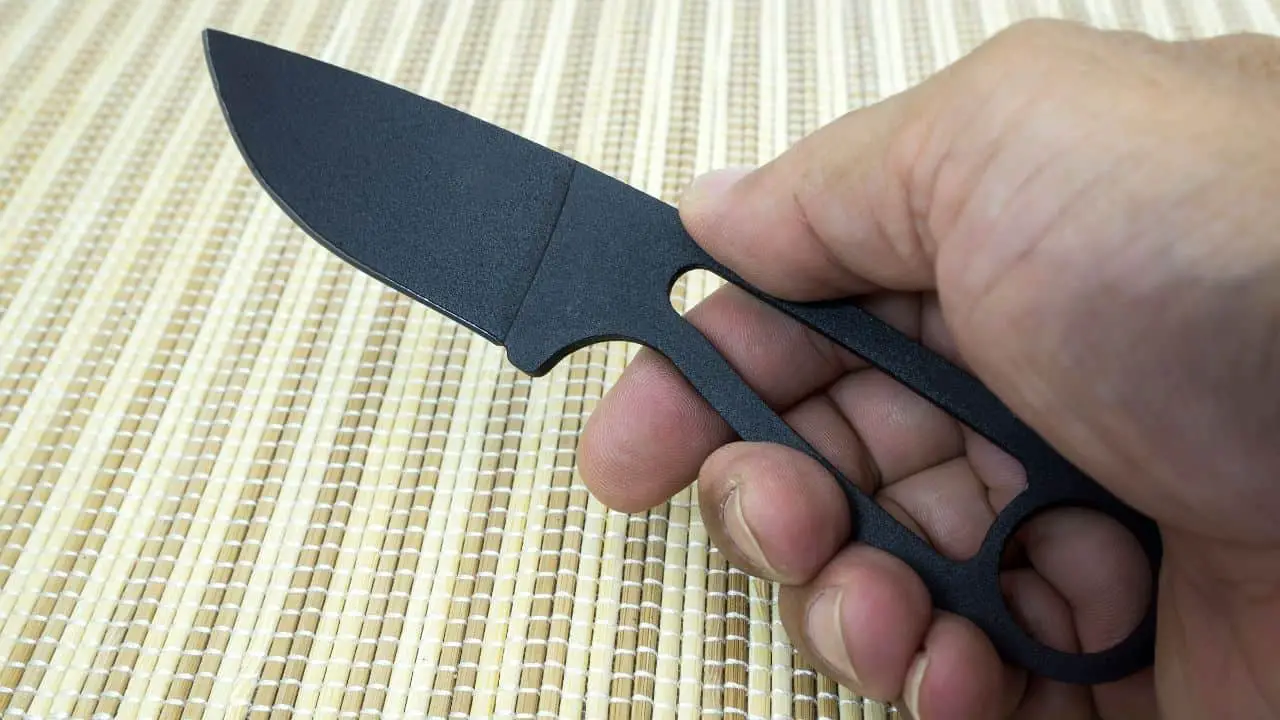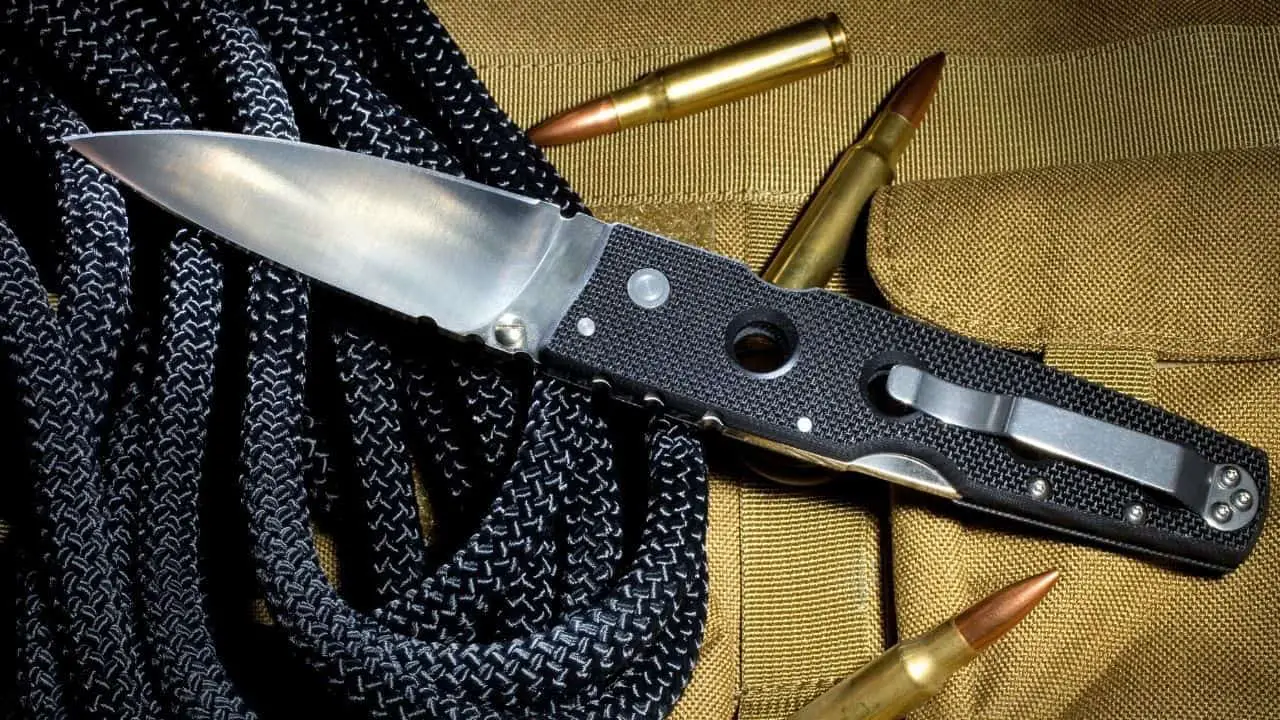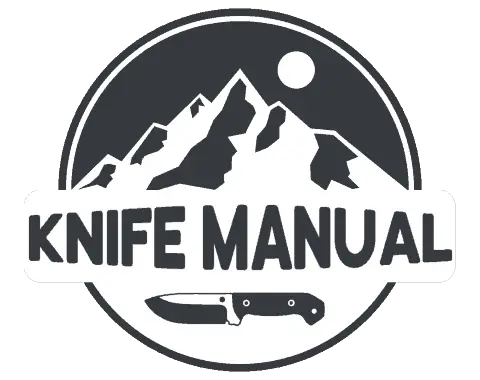Knives come in all shapes and sizes, but there are a few design elements on knives that you have to sit back and wonder what actual function they serve. Holes in the handles of knives is one such function, so why exactly do knife designers put holes in the handles of some of their knives? I’ve done a ton of research, and this is what I found.
Holes in the handles of knives are primarily there to cut down manufacturing costs and reduce the knife’s weight. Consumers can also benefit from holes in their knives’ handles because they can allow for a better grip, make it easy to attach a carabiner or lanyard, and improve the blade’s aesthetic.
When you are looking for a new knife, there are many factors that you must consider to pick out your ideal blade. Having a hole in the handle of your knife may just seem like an odd design quirk, but there there are reasons for everything. Let’s dive right in and take a look at why some knives have holes in their handles.
Table of Contents
Why Do Knives Have Holes In Their Handles?

To many people, having a hole in their knife’s handle is a very novel concept that doesn’t mean much, but there is a surprising amount of thought that goes into designing knives. Adding holes to the handles of their knives benefits knife manufacturers in many ways while also providing value to the consumer.
There are very few downsides to having a strategically designed hole placed in the handle of your knife, so it seems like a win-win situation for both knife buyers and knife companies.
If you’re interested in learning more about holes in knives and what purposes they serve, make sure to check out my other article on why knives have holes in their blades . It’s quite an interesting read that I think you’ll enjoy.
. It’s quite an interesting read that I think you’ll enjoy.
Below are a few of the most significant reasons why a knife may have a hole in its handle. There are numerous other reasons for this unique design feature, but chances are, at least a few of the ones listed below played a role in deciding the design of your knife if it has a hole in its handle.
To Cut Down on Manufacturing Costs
Manufacturing a large number of knives is extremely expensive. Many manufacturing costs fluctuate depending on a million factors, but one thing is pretty consistent no matter what company you are: small additions to knives add up over time.
Saving on material costs by cutting a hole in the handle of your knives may seem trivial when thinking of a single knife, but when multiplied by thousands of units (or even millions!), every small change makes a huge impact.
Removing a small percentage of the materials needed to manufacture a knife by placing a hole in the handle can save a company a ton of money over time if they sell a large number of knives.
To Reduce the Weight of the Knife
Another reason for knives to have holes in their handles is to reduce the knife’s weight.
Essential parts of a knife often weigh quite a bit, so if a knife maker is making an ultralight knife, they may need to remove every bit of excess material possible. Usually, the material used to make the handle of a knife makes up a good portion of the knife’s weight, so removing some of it by placing a hole in the handle is an obvious choice.
A knife manufacturer may need to reduce the weight of a knife for many reasons, but most commonly, they are trying to make a long-distance hiking knife or a knife that is simply easier and lighter to carry around.
When you’re designing knives, every ounce of material needs to serve a purpose, so removing some weight from the handle utilizing a hole just makes sense sometimes.
To Lower the Cost of Shipping the Knife
Regarding using a hole in the handle of a knife to reduce the knife’s weight, it can also cut down the cost of shipping the knife.
Many knife brands and companies have a robust online presence and sell a good portion of their knives without a physical store. Once a customer purchases a knife, the company needs to ship the blade, and any extra weight costs extra. This same principle applies if a company is importing a bunch of knives as well.
Lowering shipping costs is likely a very small consideration when deciding to put a hole in a knife’s handle. But lower shipping costs could be a factor and is at least a byproduct of the unique design choice, whether intended or not.
To Allow You To Wrap A Paracord Handle
Many knives have a large hole cut into their handle to allow you to wrap a paracord handle onto the tang of the knife. It is very popular among survival knives, but many different types of knives may have this feature.
Make sure to check out the video below for some inspiration on how you can wrap your knife’s handle with paracord.
The holes in the handle are not absolutely necessary in order to add a paracord wrapping to a knife, but they make the job a lot easier and make the resulting grip slimmer and more usable.
To Add to the Aesthetics of the Knife
Brands often try to keep a general aesthetic to their brand, and placing holes in the handles of your knives definitely adds to particular aesthetics and can make the knife stand out from the crowd.
Holes in the handles of knives is a unique design choice that lends itself to being quite sleek, modern, and minimalistic when done correctly.
Some knives have holes in their handles for the sole purpose of add to the knife’s overall minimalist and sleek aesthetic. After all, the design of a knife is one of the most significant factors for many people when choosing a new blade, so it makes sense that it would be a reason for companies to put holes in the handles of their knives.
Not all design choices on knives are part of a bigger plan to cut costs or make the knife more efficient; sometimes, they’re just cool.
To Improve The Knife’s Grip

Holes in the handle of a knife can also improve the knife’s grip. Some knives have super slippery handles, and holes in the handle can improve the grip and enable the user to have more control over the blade.
Many tactical knives, such as this first responder folding knife , utilize small holes in the knife’s handle to improve its grip. Some knife designs allow you to stick your fingers through the holes in the handle, while others are just there to make the handle more tactical and grippy.
, utilize small holes in the knife’s handle to improve its grip. Some knife designs allow you to stick your fingers through the holes in the handle, while others are just there to make the handle more tactical and grippy.
Texturing the handle of a knife for increased control and grip is nothing new. However, you often see it as a textured material handle and not actual holes through the knife’s handle. But holes work just as well, if not better, in many cases and have many other functions and benefits as well.
To Allow a Lanyard or Carabiner Clip to be Attached Easily
Sometimes, clipping your knife to your pants pocket using a pocket clip or just sticking it into your pocket isn’t safe enough, so you want an extra method of attaching your knife to yourself. There are a million and one ways to secure and carry your knife, and most use a carabiner clip, lanyard, or other attachment string.
By having a hole in the handle of your knife, you’re able to quickly and easily attach a carabiner clip or lanyard of your choice.
A carabiner clip allows you to quickly disconnect your knife from your backpack or belt to use it. Without a hole in our knife’s handle, connecting these third-party attachment systems to your knife would be a big hassle and often wouldn’t even be worth the effort.
Do Holes In The Handle of a Knife Decrease Its Structural Integrity?
The structural integrity of a knife is usually not compromised by an intentional hole in the handle if it has been designed that way.
As you might suspect, punching a hole in the handle of a regular knife that was not supposed to have one will severely weaken or break it. But if a knife maker designs a knife to have holes in the handle, chances are, it won’t be any weaker because of the design feature.
There is a ton of thought, testing, and time that goes into designing a knife. If a hole in the handle severely impacted a knife’s integrity, it likely wouldn’t get the green light and go into production.
Like nearly everything, I’m sure there are some exceptions out there where the intentional holes in a knife’s handle weakened the tool and compromised its structural integrity. But most knife companies are more careful than that will only put a hole in the handle of one of their knives if it actually serves a purpose and doesn’t ruin the rest of the knife.
Should You Get a Knife That Has Holes in Its Handle?
Whether you should get a knife with holes in its handle or not is mostly up to personal preference.
There are no significant downsides to having holes in your knife’s handle, so there isn’t any particular reason to avoid them. In fact, knives with holes in their handles can be quite useful, and many people enjoy the versatility and additional advantages that they bring to the table.
Personally, I could take or leave holes in the handles of my knives. While they do serve a few purposes, I don’t use their functionality too often in my everyday life.
While I wouldn’t intentionally seek out a knife with holes in its handle, if you happen upon a knife that has them, don’t let that be the deciding factor in your not getting the blade.
Below are a few knives that have holes in their handles that I think are worth checking out:

